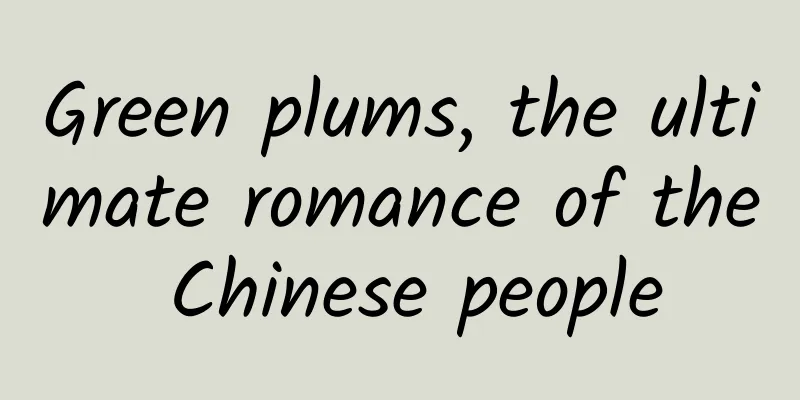Green plums, the ultimate romance of the Chinese people

|
Written by Wei Shuihua The Latin scientific name of plum is Prunus mume. Prunus means a plant of the Rosaceae family, and mume is the transliteration of the Chinese word "plum". Even in a global perspective, plums still have a distinct Chinese flavor. If porcelain, silk and tea represent the oriental virtues of tenacity, gentleness and modesty, then plums are the concentrated presentation of the Chinese people's elegance and tolerance. Whether eaten fresh, pickled, made into sauce or soaked in wine, plums, with their subtle sweetness and sharp sourness, quietly influence the Chinese way of life. They are the main theme of Chinese flavor, the main theme of Chinese aesthetics, and the protagonist of Chinese demeanor. ©Qingmei, a witness to Chinese lifestyle No.1 According to the laws of plant selection and breeding, edible fruits are always becoming sweeter - farmers will pick out fruits that are sweeter, juicier, and more acceptable to most people to plant, in the hope of selling them at a good price next year. But the development of plums does not seem to be limited by this rule. "There is a large plum forest in front, with abundant plums, and the sweet and sour taste can quench thirst." This is what Cao Cao said in "Shishuo Xinyu" in the fifth century AD; "The sour plums soften the teeth, and the green banana leaves are shared with the window screen." This is a poem written by Yang Wanli in the twelfth century AD. Over thousands of years, the taste of plums has not changed much. Sourness is the main flavor, and sweetness is the secondary flavor, which dominates its flavor. The reason is simple: plums are not only a kind of food, but also a natural seasoning. © China Puning Meijian Green Plum Base The Book of History says, "If you want to make a soup, you should use salt and plums." Obviously, before the Qin and Han dynasties, salt and plums were the two most important cooking condiments for the Chinese. Especially plums, before the invention of vinegar brewing technology, it was the source of sourness. The total organic acid content of plums is generally around 5%, and some are even higher than 6.5%. It is the sourest fruit known to mankind. In addition, the types of organic acids in plums are also the highest among all kinds of fruits, including citric acid, malic acid, ursolic acid, catechin and acetic acid, which constitute a rich and multi-layered sour taste. Some people describe it as a mixture of grapes, citrus, oxidized metals, fermented meat and grains. Because of its complexity, it can be used in many ways: whether used in cooking, as a side dish for wine, or even used to make wine, plums are always successful. © Plum Spare Ribs To this day, many dishes of steaming fish and boiling meat with plums are still preserved in Sichuan and Cantonese cuisines. They have very different flavors from other "sour" methods such as shrimp and crab with vinegar, fried fish with ketchup, stewed pork bones with pickled cabbage, and fried steak with lemon. In the wine culture that better represents the Chinese style, plums also play an important role. In the fifth century AD, the Chinese poet Bao Zhao had already written the sentence "I remember the days when I loved to drink, with green plums on a plain plate." This was the first time in human history that plums and wine were described in the same scene. Vegetarian plates, green plums, drinking, happiness, everything is packed in "memories", creating a strong, melancholy and elegant sense of scene. Mei Zi is undoubtedly the soul of this scene. ©Supanjinqingmei Its sweet and sour taste brings out the sweetness, mellowness, astringency and aftertaste of the wine; and its bright green appearance embodies the drinker's memories of the past, old friends and youth. The romance of the Chinese people is infinitely extended at this moment. No.2 The Chinese have long understood the principle of "drying creates fragrance". For example, pickled and dehydrated ham, sun-dried dried shrimp, smoked sausage, and wind-dried abalone, while extending their shelf life, they lose moisture, concentrate flavor substances, and break down their molecular structures, giving rise to a sudden fragrance. Generally speaking, fruits with high acidity are easier to preserve. Fruit acid inhibits the growth of bacteria, and fruit wax provides a protective layer against external microorganisms - plums are an exception. Due to their rich organic matter and thin peel, plums that are not processed in time after being picked for consumption often become a breeding ground for insects, ants and mold. As the Book of Songs says, "Pick the plums, and put them in baskets. Ask my common people for help, and wait for them to call me." - While the Creator has given the plum an incomparable flavor, he has also made it noble and delicate. Therefore, from the very beginning, plums have been given the label of private enjoyment. It is a delicacy that can only be enjoyed by a few people at a limited time. ©Perfectly ripe plums, with a good balance of sourness and sweetness As Xie Yi wrote in his poem, "I pick green plums and try to cook wine, and then boil white snow to try new tea." Whether it is green plums and new tea that need to be tasted in season, or ice and snow and fine wine that need to be stored in the cellar, the complementary color matching and beautiful taste are all the manifestation of the luxurious lifestyle of the aristocracy and scholars. The Chinese therefore invented salting and smoking, which, to a certain extent, improved the application scenarios and storage period of plums. In addition to inhibiting the growth of mold, salting and smoking can also cause osmotic pressure imbalance, causing the plums to lose water and become dry. A large number of amino acids representing umami flavor are precipitated in this process, and the Maillard reaction also produces brown substances representing freshness and fragrance. This gives pickled and smoked umeboshi a completely different, more wonderful flavor than fresh umeboshi. ©Plum preserves for drinking The Qi Min Yao Shu, written in the sixth century AD, records the methods of pickling white and black plums: for white plums, pick them when the core is just formed because they are sour. Soak them in salt juice at night and expose them to the sun during the day. Soak them ten times a night and ten times, and they will be ready in ten days; for black plums, pick the cores when they are just formed, put them in a basket, and smoke them on a slab to dry them. Obviously, this is not much different from today's sun-dried plums and smoked plums. © Dried and fragrant plums Compared with green plums, pickled and smoked plums go better with fine wine. They have a very rich taste, and all the sour, astringent, salty, sweet and fresh flavors are concentrated in a small size due to dehydration. Undistilled fermented wine contains a lot of residual sugar and has a naturally sweet flavor, which can neutralize the sourness of prunes. The strong taste of prunes relieves the irritation of the wine to the mouth and prolongs the time for drinking, chatting and socializing. © Plums are a great accompaniment to meals, a culinary masterpiece that embodies the millennium elegance of Chinese cuisine As Su Shi said in his poem: "Don't try to cook wine while the plums are green, but wait for the yellow plums to ripen in the drizzle." This is a microcosm of the evolution of people's taste buds due to technological progress; But from an aesthetic point of view, people are willing to pay more and wait for good taste: it expresses that after hundreds of years of development, Chinese people have a more gentle and peaceful character, a more meticulous attitude and a more delicate heart. Together, they demonstrate the Chinese people's feelings towards plums and also bear witness to the important position of plums in Chinese culture. ©Meijian Forest Tavern: Gathering around plum blossoms No.3 After the Tang and Song dynasties, plums and wine became increasingly a standard dish at banquets for the aristocratic and scholar-official classes. In another dream, I was rubbing plums with my hands and tasting wine for the first time. The loneliness lasts through spring, but the small bridge is still busy with flying swallows. The jade railing, gradually becomes warmer as you lean on it, the golden pillow, still smells fragrant after a long separation. The most unforgettable. Watching the flowers in the south lane and waiting for the moon in the west wing. This is a sentence from the poet Chao Chongzhi: The so-called boiling wine refers to the practice of killing bacteria by low-temperature heating during the brewing process of grain wine, which is the prototype of "pasteurization". Before the invention of distillation technology, this was an extremely advanced process to improve the drinking safety factor of low-alcohol wine and extend its shelf life. Rubbing the plums is done by rubbing them with your hands to shake off excess salt on the surface of the plums, making their taste more mellow and mellow. Apparently, people at that time were already quite skilled in drinking green plums with wine. The combination of "jade hook railing, golden pillow, watching flowers on the southern road, waiting for the moon in the west wing" outlines the elegant people, utensils and beautiful scenery in the whole banquet process. The Chinese people's romance with plum blossoms and wine reached its peak during the Tang and Song dynasties. ©Jinmeijian, extracted smoked plum essence flavor Of course, the story of plum and wine does not end here. On the contrary, with the advancement of the times and the iteration of technology, they have ushered in new opportunities. Around the 13th century, the liquor distillation technology from Central Asia was introduced to China and spread widely among the people. Since then, Chinese liquor has broken the 24% alcohol limit and began to appear with 40%, 50% and even 60% alcohol content. The legends of Wu Song and others before the Song Dynasty, such as "three bowls of wine to cross the guard post and fight the tiger", have never appeared again. ©The maturity of China's distilled liquor technology gave birth to the new plum wine The taste of high-proof liquor is cleaner and mellower, and it gets you drunk faster. More importantly, the higher alcohol content can effectively prevent the plums from becoming moldy and worm-eaten. When the plums that have been dried in the sun are soaked in distilled liquor, alcohol-soluble and water-soluble organic matter such as fruit acid, fructose and brown compounds can gradually precipitate, reducing the alcohol content and making the taste of the liquor round and smooth. Eating green plums and drinking boiled wine gradually evolved into soaking green plums in shochu. The problems of plums being easily infested by insects and liquor becoming sour, which had troubled transportation before the Tang Dynasty, were solved. Plum wine became a national drink that benefited the general public and had a stronger popular base. In the era when Luo Guanzhong wrote Romance of the Three Kingdoms, the chapter "Discussing Heroes over Green Plum Wine" was not so much a reproduction of the banquet scene between Cao Cao and Liu Bei in the Han and Wei dynasties, but rather a reflection of the thousand-year-old historical wave in which the aristocratic lifestyle finally reached ordinary people. A small bottle of plum wine condenses the elegance and romance of the Chinese people, and also embodies the Chinese nation's courage to look outward and determination to look forward. ©The orderly inheritance of plum wine, the all-encompassing Chinese dining table No.4 The past is thousands of years old. Last year, at the Meijian green plum planting base, a "Meijian Night Banquet" with the perfect combination of sight, sound, food and elegance was held, replicating the banquet scene of Chinese people in the 8th century AD. ©Night Banquet of Han Xizai (partial) In a hidden plum forest, plums are hanging and the breeze is blowing. "Left Prime Minister Li Shizhi" is holding a banquet in the garden, and "Poet Cui Zongzhi" has mistakenly entered the deep part of the plum garden. Under the bright moon, mountain springs are flowing, and the fragrance of green plums on the branches is intoxicating. Musicians, calligraphers, and connoisseurs appear one by one. This elegant banquet of literati, like "Night Banquet of Han Xizai", slowly begins. The guests toasted each other, talked and laughed, played bamboo and string instruments, and composed poems. Occasionally, ripe green plums fell on the table, presenting the four-fold beauty of sound, picture, taste and artistic conception. Plums and wine are the organizers and connectors of the banquet, and they are also the soul protagonists of this elegant banquet that dreams back to the Tang Dynasty. "Wine stimulates poetry" is the most condensed presentation of Tang and Song culture. Wine stimulates poetry, plum blossoms present the fragrance of wine, and poetry praises the elegance of plum blossoms. Poetry, wine, and plum blossoms complement each other and brew together at the material and spiritual levels, ultimately forming a night banquet of plum blossoms that spans thousands of years. From reciting poems and drinking games to improvising poems, the encounter between the two "wine immortals" is not just about drinking, but also about drinking culture. It declares that Chinese brands are looking for strength from the 5,000-year-old cultural matrix, and the high-quality texture and spiritual elements of Chinese brands have formed a beautiful synaesthesia around the world. ©Plum wine awakens the Chinese people's elegance and elegance Yes, the real national trend and style is by no means as simple as using Chinese elements in visual packaging. In spirit and temperament, it is deeply rooted in the soil of Chinese civilization. ©The story of Meizi is the story of China -END- The bottle design of "Meijian", the number one plum wine brand in China, is very intriguing. The character "梅" is taken from the calligraphy of Lu Jianzhi from the Tang Dynasty; while the character "见" is from the handwriting of Zhao Mengfu from the Yuan Dynasty. From the perspective of historical development, it is not only a dialogue between two calligraphy schools that connects the millennium time tunnel, but also expresses the designer's tribute to the two eras of China's development: It reflects the tranquil, elegant and unique Tang and Song style of the Chinese people; it also presents the demeanor of a great country that has become increasingly open and inclusive from the Yuan, Ming and Qing dynasties to the present. A cup of green plum wine lasts for a thousand years. |
<<: It’s the “sneezing” season again. What’s making me sneeze non-stop?
Recommend
A comprehensive introduction to OPPO's advertising marketing platform and advertising types
OPPO Marketing Platform is a media platform based...
There are so many green radishes in the world, but isn't there a single one that blooms?
As one of the most successful indoor cultivated p...
Can 5G extend the life of HTC’s desperate VR business?
5G is like a "tonic pill" that has sudd...
A comprehensive review of the top ten most classic interactive marketing cases!
Today, I will take you to review the top ten inte...
Great Wall WEY VV7 real shot at Guangzhou Auto Show: Can front-wheel drive SUV challenge Toyota Land Cruiser?
More and more domestic automobile brands have reg...
More than 200 children became "star chasers" because of him!
“Craters and lunar seas can be seen clearly” Rece...
How to promote and operate WeChat mini programs? How to promote and attract traffic for WeChat Mini Programs?
This is the best of times, and the worst of times...
10 kinds of strange plants, how many do you know?
Among all living things, the plant kingdom is a m...
Ministry of Commerce: Parallel import pilot projects see significant price cuts for mid- to high-end cars
The Ministry of Commerce held a regular press con...
China Automobile Dealers Association: September 2020 Automobile Market Insights and Price Monthly Report
Recently, the China Automobile Dealers Associatio...
Night Grass and Qianlima Episode 18 "Douyin Copywriting Class for Those Who Can Be Popular Just by Having a Mouth"
Resource introduction of the 18th issue of Night ...
China's new energy vehicles had a bad start in 2017 and need to improve both internally and externally to stop the bleeding
At the beginning of the new year, China's new...
Can I modify the authentication information after authenticating the Douyin corporate account? Can I change my name after authenticating the Douyin account?
Douyin's "Enterprise Certification"...
Latest Age Regulations for Construction Workers 2022: What is the age limit for migrant workers on construction sites?
In rural areas, many farmers are forced to work i...
#千万IP创科学热门# You’ve heard of motion sickness and seasickness, let’s learn about “screen sickness”!
Motion sickness, seasickness, and airsickness are...









